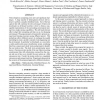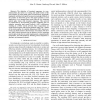233 search results - page 29 / 47 » Learning Complexity Dimensions for a Continuous-Time Control... |
NIPS
2007
13 years 8 months ago
2007
We consider apprenticeship learning—learning from expert demonstrations—in the setting of large, complex domains. Past work in apprenticeship learning requires that the expert...
SASO
2008
IEEE
14 years 1 months ago
2008
IEEE
Truly ubiquitous computing poses new and significant challenges. A huge number of heterogeneous devices will interact to perform complex distributed tasks. One of the key aspects...
SMC
2007
IEEE
14 years 1 months ago
2007
IEEE
—Reinforcement learning is a framework in which an agent can learn behavior without knowledge on a task or an environment by exploration and exploitation. Striking a balance betw...
VC
2008
13 years 7 months ago
2008
In real-time animation systems, motion interpolation techniques are widely used for their controllability and efficiency. The techniques sample the parameter space using example mo...
CDC
2008
IEEE
14 years 1 months ago
2008
IEEE
— The detection of transient responses, i.e. non– stationarities, that arise in a varying and small fraction of the total number of neural spike trains recorded from chronicall...


